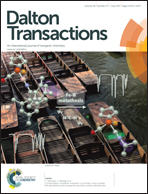Experimental and theoretical studies of highly emissive dinuclear Cu(i) halide complexes with delayed fluorescence†
Abstract
A series of luminescent homo-dinuclear Cu(I) halide complexes, [PPh2PAr2Cu(μ-X)2CuPPh2PAr2] (X = I (1), Br (2), Cl (3)) (PPh2PAr2 = (1-bis(2-methylphenyl)phosphino-2-diphenylphosphino)benzene) were synthesized from the reaction of the corresponding cuprous halide and the chelating bisphosphine ligand PPh2PAr2 in CH3CN. The complexes were structurally characterized by X-ray single crystal analysis. Their photophysical properties were studied in detail. The Cu(I) atoms in these complexes are four-coordinated and adopt a tetrahedral coordination geometry. In each complex, the copper centers are bridged by two halide anions and each Cu(I) is chelated further terminally by a PPh2PAr2 ligand. The[Cu(μ-X)2Cu] cores have similar butterfly-type configurations. The distances between the Cu(I) atoms in each complex are over 2.94 Å. In the solid state, these complexes are highly emissive and exhibit bluish-green photoluminescence (emission peaks, λmax = 488 nm (1), 482 nm (2), 490 nm (3)) with short lifetimes (4.9–5.9 μs) and high quantum yields (ϕ = 0.42–0.95) at room temperature. In this series of complexes, the ligand-field strengths of the ions (I− < Br− < Cl−) do not have obvious effect on the emission maxima. The studies on varied temperature emission spectra and decay behaviours of these complexes indicate that the mechanism of their emissions involves two thermal-equilibrium excited states. At room temperature, the complexes display thermally activated delayed fluorescences with short decay lifetimes. With a decrease of the temperature, a significant increase of emission decay times by almost 2 orders of magnitude is observed. At temperatures below T ≈ 100 K, the decay times of the studied complexes are over one hundred microseconds long, which indicates that the emission originates mainly from the triplet state (T1 state). To interpret the varied temperature photophysics of these complexes, an equilibrated 2 excited states model S0 ← T1 ↔ S1 → S0 was used. The results of the experimental and DFT calculations suggest that the emission in the solid state originates from the 1,3(MLCT + XLCT + ILCT) excited states, in which emissive excited states, 1S and 3T, are in equilibrium with an energy difference of about 0.055 eV. The process of the reverse intersystem crossing was estimated to be in the order of 2 ns.


 Please wait while we load your content...
Please wait while we load your content...